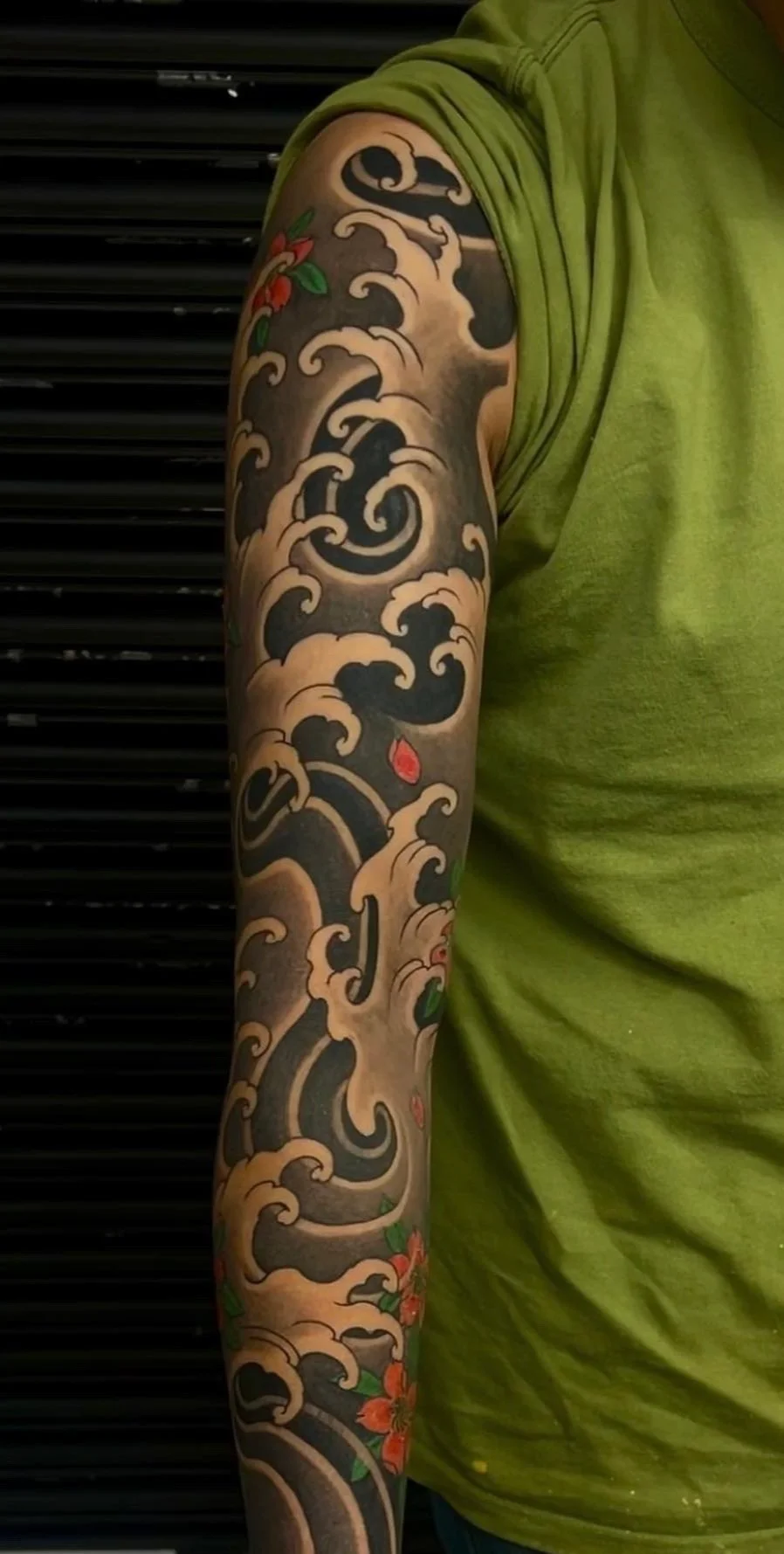
Japanese
and Chinese
In recent years, tattoos have transcended their historical boundaries to become mainstream forms of self-expression and artistry. Among the diverse styles that have gained global popularity, Japanese, Chinese, and Oriental tattoos stand out for their rich cultural heritage, intricate designs, and profound symbolism. This guide explores the history, evolution, and current popularity of these tattoo styles, focusing on their significance in contemporary tattoo culture.
History of Japanese Tattoos
Japanese tattoos, known as irezumi (入れ墨), have a centuries-old tradition deeply rooted in Japanese culture and aesthetics. Historically, irezumi was associated with the criminal underworld and later evolved into a celebrated art form. The Edo period (1603-1868) saw the flourishing of irezumi among the samurai and commoners alike, where tattoos served as marks of bravery, social status, and spiritual protection.
Key Elements of Japanese Tattoos:
• Subjects and Motifs: Traditional Japanese tattoos feature iconic motifs such as dragons, koi fish, cherry blossoms, and mythical creatures like the phoenix and foo dogs.
• Design Characteristics: Bold outlines, vibrant colours, and intricate patterns characterise Japanese tattoo designs, often covering large areas of the body in a cohesive composition.
• Symbolism: Each motif in Japanese tattoos carries deep symbolic meanings, reflecting themes of courage, strength, resilience, and spirituality.
Evolution of Chinese Tattoos
Chinese tattoos have a distinct artistic tradition that draws upon millennia of cultural heritage and symbolism. Unlike Japanese tattoos, which developed their unique style primarily through irezumi, Chinese tattooing has evolved from a combination of historical records, literature, and artistic depictions.
Key Elements of Chinese Tattoos:
• Symbols and Meanings: Chinese tattoos often feature characters from Chinese calligraphy, such as blessings, fortunes, and philosophical concepts like yin and yang, which embody harmony and balance.
•Animal Symbolism: Animals like dragons, tigers, and phoenixes are prevalent in Chinese tattoos, each symbolising virtues like power, protection, and prosperity.
•Influence of Taoism and Buddhism: Taoist and Buddhist elements, including deities, mythical creatures, and spiritual symbols, are also common in Chinese tattoo designs, reflecting beliefs in spirituality and cosmic harmony.
Oriental Tattoos: Fusion of East Asian Cultures
The term “Oriental tattoos” encompasses a broader spectrum of East Asian tattoo styles beyond just Japanese and Chinese influences. This category includes tattoos inspired by Korean, Vietnamese, and other regional artistic traditions, each with their own unique aesthetics and symbolism.
Characteristics of Oriental Tattoos:
Tattoos from different East Asian cultures exhibit a rich tapestry of motifs, styles, and symbolic meanings, reflecting the diversity of cultural influences and historical contexts across the region. Traditional Oriental tattoos are renowned for their fine line work, delicate shading, and intricate details, which emphasise precision and craftsmanship. In modern times, these ancient art forms have evolved, with contemporary interpretations blending traditional motifs with innovative tattoo techniques. This fusion creates a unique synthesis of old and new artistic expressions, bridging historical depth with modern creativity.
WHY CHOOSE COMPENDIUM
Japanese, Chinese, and Oriental tattoos represent more than just body art; they are intricate expressions of cultural heritage, artistic skill, and personal identity. As these tattoo styles continue to evolve and gain popularity worldwide, they enrich the global tattoo landscape with their timeless beauty and profound symbolism. Traditional Oriental tattooing often features mythical creatures and deities, and at Compendium Tattoo, artist Evan Xia exemplifies the art form’s rich traditions. Merging the intricate techniques of Japanese and Chinese tattoo art, Evan pushes the boundaries of these styles with grand-scale pieces, such as detailed Yakuza-style bodysuits and sleeves. His work blends cultural reverence with contemporary flair, meticulously crafted to honor the deep symbolism of Oriental tattooing while introducing innovative artistry.
For those considering a Japanese, Chinese, or Oriental tattoo, Melbourne offers a vibrant tattoo community where talented artists like Evan can bring your vision to life. Whether you are captivated by the bold lines of Japanese irezumi, the intricate characters of Chinese calligraphy, or a fusion of East Asian aesthetics, your tattoo experience at Compendium Tattoo can be a transformative exploration of artistry and cultural richness. This guide delves into the historical roots, artistic elements, and contemporary significance of these tattoo styles, providing insight and inspiration for both enthusiasts and cultural aficionados. Discover the allure of these timeless tattoo styles at Compendium Tattoo and embark on a journey that celebrates tradition, creativity, and personal expression through the exceptional artistry of Evan and our skilled team.
日本、中國和東方紋身代表的不僅僅是身體藝術,更是文化遺產、藝術技巧和個人身份的複雜表達。隨著這些紋身風格的不斷發展和在全球的普及,它們以其永恆的美感和深刻的象徵意義豐富了全球的紋身領域。傳統的東方紋身通常以神話生物和神祇為主題,在 Compendium Tattoo,藝術家 Evan Xia 盡顯了這種藝術形式的豐富傳統。Evan 融合了日本和中國紋身藝術的複雜技術,以大規模的作品突破了這些風格的界限,例如細緻的 Yakuza 風格連身紋身服和袖紋身。他的作品融合了對文化的崇敬和當代風格,精心雕琢,在尊重東方紋身的深刻象徵意義的同時,也引入了創新的藝術手法。
對於那些考慮紋身日本、中國或東方紋身的人來說,墨爾本提供了一個充滿活力的紋身社區,像 Evan 這樣的天才藝術家可以將您的願景實現。無論您是被日本紋身大膽的線條、中國書法複雜的字體,還是東亞美學的融合所吸引,您在 Compendium Tattoo 的紋身體驗都將是一次對藝術和文化豐富性的探索。在 Compendium Tattoo 探索這些永恆紋身的誘惑,透過 Evan Xia 卓越的藝術表現,踏上讚頌傳統、創意和個人表達的旅程。




